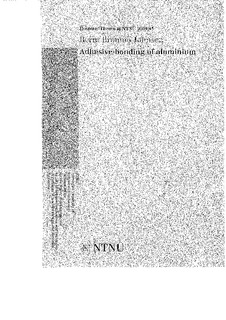| dc.contributor.author | Johnsen, Bernt Brønmo | nb_NO |
| dc.date.accessioned | 2014-12-19T11:24:53Z | |
| dc.date.available | 2014-12-19T11:24:53Z | |
| dc.date.created | 2004-08-23 | nb_NO |
| dc.date.issued | 2004 | nb_NO |
| dc.identifier | 125429 | nb_NO |
| dc.identifier.isbn | 82-471-6294-6 | nb_NO |
| dc.identifier.uri | http://hdl.handle.net/11250/231250 | |
| dc.description.abstract | In order to get approval of adhesive bonding as a reliable joining method in the automotive industry, a better understanding of the interfacial interactions between aluminium surfaces and adhesives is important. It is also important to get a better understanding of the degradation mechanisms of the bonded systems in humid environments, as humidity is known to have a detrimental effect. This work has been focused on an aluminium alloy and a one-component epoxy adhesive that are of particular interest to the automotive industry.
Pretreatment of the aluminium substrates before adhesive bonding is essential. However, the most successful pretreatment processes involve the use of hexavalent chromium, which will be banned from use within few years due to environmental considerations. Alternative pretreatments need to be developed. A literature study identified silanisation with GPS as a pretreatment method with the potential to obtain good durability. On the basis of research performed by SINTEF Materials Technology, AC anodising in hot phosphoric and sulphuric acid solutions were also identified as interesting pretreatment methods.
A modified version of the Boeing wedge test was used to determine the durability of adhesively bonded joints tested in hydrothermal environments. The joints were made of AA6060-T6 aluminium alloy and Betamate XD4600 epoxy adhesive. Both silane films and anodic oxides were investigated using reflection-absorption FT-IR spectroscopy. Other techniques of surface analysis were also used (SEM, TEM, WLI, XPS, ToF-SIMS and contact angle measurements).
The environmental durability of pretreated AA6060-T6 substrates was significantly improved after silanisation with GPS. The grit-blasting + GPS pretreatment process resulted in considerable higher durability then the chromic-sulphuric acid FPL-etch. The general understanding is that silanisation improves the durability through the formation of strong, covalent bonds between the aluminium surface and the adhesive. FT-IR spectroscopy strongly indicated that a chemical reaction took place between GPS films and amine curing agents. Particularly interesting was the reaction with dicyandiamide, which is a common curing agent in one-component epoxy adhesives. The amines also catalysed the condensation of SiOH groups, resulting in higher degree of SiOSi crosslink density in the siloxane films. However, chemical reaction is not necessary for improved durability. The hydrophobicity of the bonded surface is also an important factor. This effect has not been studies extensively earlier.
Exposure of GPS films to degrading environments showed that the silane desorbed from the surface in acidic solutions, but it was stable in alkaline solutions. The durability of adhesive joints was also reduced in acidic environments. The two models for the degradation of the silanised aluminium surface in acidic environments were proposed: hydrolysis of the siloxane network and corrosion of the underlying aluminium surface.
The environmental durability of substrates that were AC anodised in hot phosphoric and sulphuric acid solutions was good, almost as good as the well-established FPL + PAA pretreatment. DC anodising in sulphuric acid gave inferior durability. FT-IR spectroscopy showed that the anodic films formed in sulphuric acid contained significant amounts of sulphate. This can have a significant negative effect on the long-term properties of bonded joints. The anodic films released water during curing of the adhesive. The observations suggested that a transformation from the hydroxide to the oxide state took place.
Adhesive bonding in wet environment of substrates that were anodised in sulphuric acid had a negative effect on durability. The effect was more pronounced for DC anodised, than for AC anodised substrates. Bonding in wet environment also resulted in changed adhesive properties close to the oxide surface. Very little thixotropic agent was present in a ~200 nm wide region in the adhesive. This was explained by desorption of water from the oxide during curing of the adhesive. | nb_NO |
| dc.language | eng | nb_NO |
| dc.publisher | Fakultet for ingeniørvitenskap og teknologi | nb_NO |
| dc.relation.ispartofseries | Doktoravhandlinger ved NTNU, 1503-8181; 2004:43 | nb_NO |
| dc.relation.haspart | Johnsen, Bernt Brønmo; Olafsen, Kjell; Stori, Aage; Kristin, Vinje. Silanisation of adhesively bonded aluminium alloy AA6060 with γ-glycidoxypropyltrimethoxysilane. I. Durability investigation. Journal of Adhesion Science and Technology. 16(14): 1931-1948, 2002. | nb_NO |
| dc.relation.haspart | Johnsen, Bernt Brønmo; Olafsen, Kjell; Stori, Aage. Reflection-absorption FT-IR studies of the specific interaction of amines and an epoxy adhesive with GPS treated aluminium surfaces. International Journal of Adhesion and Adhesives. 23(2): 155-163, 2003. | nb_NO |
| dc.relation.haspart | Johnsen, Bernt Brønmo; Olafsen, Kjell; Stori, Aage; Kristin, Vinje. Silanization of adhesively bonded aluminum alloy AA6060 with gamma-glycidoxypropyltrimethoxysilane. II. Stability in degrading environments. JOURNAL OF ADHESION SCIENCE AND TECHNOLOGY. 17(9): 1283-1298, 2003. | nb_NO |
| dc.relation.haspart | Johnsen, Bernt Brønmo; Lapique, Fabrice; Bjørgum, A.. The durability of bonded aluminium joints: a comparison of AC and DC anodising pretreatments. International Journal of Adhesion and Adhesives. 24(2): 153-161, 2004. | nb_NO |
| dc.relation.haspart | Johnsen, Bernt Brønmo; Lapique, Fabrice; Bjørgum, A.; Walmsley, John; Tanem, Bjørn Steinar; Luksepp, Tomas. The effect of pre-bond moisture on epoxy-bonded sulphuric acid anodised aluminium. International Journal of Adhesion and Adhesives. 24(3): 183-191, 2004. | nb_NO |
| dc.title | Adhesive bonding of aluminium | nb_NO |
| dc.type | Doctoral thesis | nb_NO |
| dc.source.pagenumber | 199 | nb_NO |
| dc.contributor.department | Norges teknisk-naturvitenskapelige universitet, Fakultet for ingeniørvitenskap og teknologi | nb_NO |
| dc.description.degree | dr.ing. | nb_NO |
| dc.description.degree | dr.ing. | en_GB |
